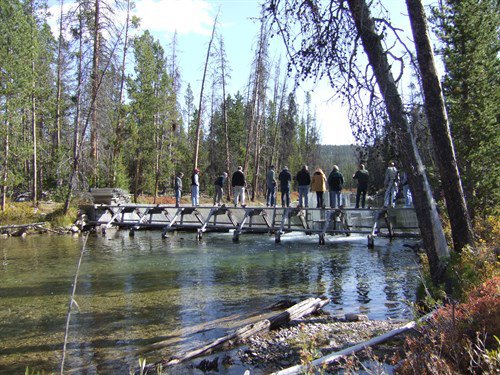A controversy for the Council: Hatchery impacts on wild fish
- November 14, 2013
- Carol Winkel

Wiers like this at the outlet of Redfish Lake in central Idaho help biologists sort wild and hatchery fish.
Like the proverbial elephant in the room, the future role of salmon and steelhead hatcheries “is one of the larger issues we will deal with,” Council staffer Peter Paquet told the Council’s Fish and Wildlife Committee Wednesday. Like an elephant in the room, the issue is impossible to ignore, but people are talking about it -- and they don’t agree.
Fish-management experts have polar-opposite opinions about whether hatchery-produced fish help or harm fish that spawn in the wild, and therefore how salmon and steelhead hatcheries should be operated in the future. They expressed those opinions in great detail to the Council in recommendations to amend the Columbia River Basin Fish and Wildlife Program. The program supports funding for artificial production programs, mostly at hatcheries run by Indian tribes, totaling tens of millions of dollars annually -- $83.4 million in 2012, for example.
By law, the Council amends the program every five years. The current program dates to 2009; a new program is expected by next summer, and this month and next the Council’s Fish and Wildlife Committee is digging into more than 480 amendment recommendations, guided by summaries prepared by the Council’s staff.
This week the committee will meet three times -- normally it’s once a month -- to review the recommendations, a major step toward writing a draft program for public comment early in 2014. Artificial production was on Wednesday’s agenda.
The Council staff sorted the artificial production recommendations into five categories:
- There is “fairly strong support,” Paquet said, for the current program, which supports an experimental fish-propagation technique known as supplementation -- releasing hatchery-bred fish into streams to build or supplement populations that spawn in the wild.
- There also is support for specific fish-production programs and facilities, such as those operated by Indian tribes and funded by the Bonneville Power Administration through the Council’s program.
- The unity breaks down, however, over hatchery-management principles. Some parties asked the Council to adopt the recommendations of the federally chartered Hatchery Scientific Review Group (HSRG), which made hatchery-specific recommendations several years ago for producing salmon and steelhead while protecting wild fish. Others told the Council to adopt instead the hatchery genetic management plans being developed by NOAA Fisheries, which implements the Endangered Species Act for salmon and steelhead. NOAA’s plans generally take a less prescriptive approach to hatchery management than the HSRG recommendations. NOAA’s plans, however, won’t be completed before the Council completes the next fish and wildlife program. Tony Grover, the Council’s fish and wildlife director, said the issue need not be as black and white as endorsing the HSRG recommendations or NOAA’s plans, but perhaps melding elements of both in the Council’s program.
- The elephant in the room -- whether hatcheries help or harm wild fish -- is a dilemma for the Council because the program currently supports supplementation hatcheries and recommendations both supported and opposed supplementation. Paquet asked: “To what extent should the program put in place metrics that protect wild fish while acknowledging the competing science on the issue? The Council will have to choose which path it wants, and it could be a fairly difficult issue.”
- Monitoring and evaluating the success of hatcheries is a controversial subject without a clear consensus among the recommendations. In light of the differences on hatchery-management policy between the Columbia River Inter-Tribal Fish Commission and NOAA Fisheries, the Council’s role could be to bring the two sides together to find common ground and develop a workable monitoring and evaluation strategy. “This is an area where there are some tough decisions to be made and obviously some strong positions about which way to go,” Paquet said.



